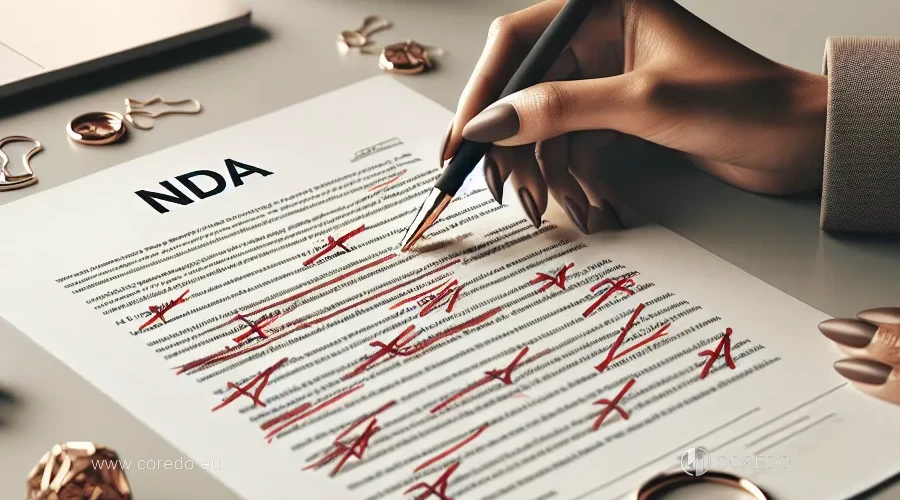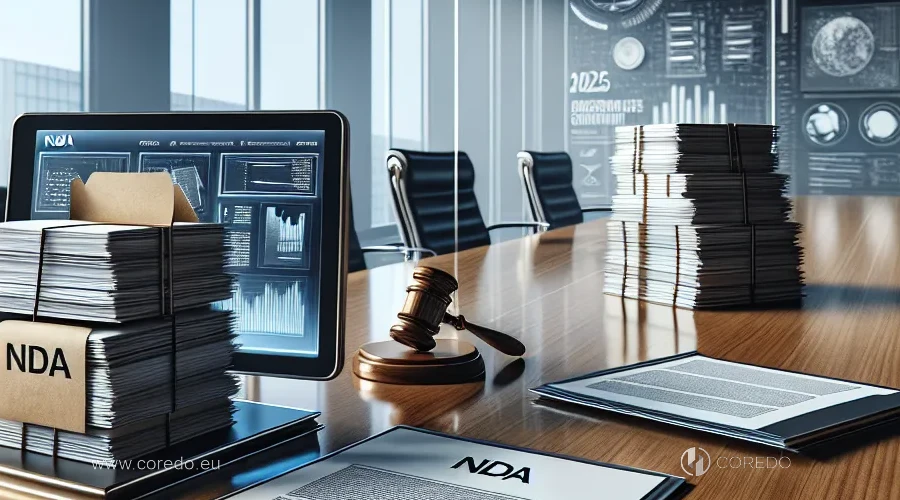Types of NDA: Unilateral, Bilateral, Multilateral
- Unilateral NDA: applied when only one party (the disclosing party) provides confidential information, and the other (the receiving party) is obligated not to disclose it. Most often used in hiring employees or working with contractors.
- Bilateral NDA: both parties exchange confidential information and are obligated to keep it secret. This format is relevant for negotiations between companies, joint developments, M&A deals.
- Multilateral NDA: includes three or more participants, each of whom can be either a disclosing or receiving party. This solution is often used in large projects, international consortia, and technology startups.
NDA to Protect Trade Secrets and Data
- Protect intellectual property (patents, know-how, source code, business models).
- Preserve trade secrets, from financial models to client bases.
- Comply with GDPR and national data protection laws, especially with cross-border information transfer.
- Strengthen trust between partners, investors, and customers.
How to Draft an NDA Independently in 2025

If you have decided to understand how to draft an NDA independently in 2025, it is important to understand each step of this process and its key nuances. Even basic steps: from defining the agreement’s goals to identifying the parties, significantly influence how effectively your NDA will protect confidential information.
Defining NDA Goals and Parties
- The purpose of the agreement: protection of trade secrets, intellectual property, personal data, or comprehensive protection.
- Parties: who discloses the information (disclosing party) and who receives (receiving party). In the case of bilateral or multilateral NDA: all participants must be clearly identified.
- Scope of information: what data is considered confidential, and what are the criteria for their classification.
Mandatory Sections of an NDA: What to Include in 2025
| NDA Section | Mandatory | Recommended | Description/Notes |
|---|---|---|---|
| Definition of parties | Disclosing and receiving party | ||
| Subject of the agreement | What is considered confidential information | ||
| Term of NDA | Specific terms and renewal conditions | ||
| Liability and sanctions | Amount of compensation, sanctions for disclosure | ||
| Dispute resolution procedure | Arbitration, court, applicable law | ||
| Data storage procedure | Conditions of storage, data destruction | ||
| NDA update procedure | Procedure for updating the document | ||
| Electronic signature | Possibility of signing in digital document flow |
- Precise definition of confidential information.
- NDA duration: for different types of information, the duration may vary (e.g., for trade secrets – 3 years, for personal data, until the end of processing).
- Sanctions for disclosure: amount of compensation, damage calculation mechanism, possibility of fines.
- Dispute resolution procedure: choice of arbitration or court, applicable law.
- Data storage conditions: where, how, and in what form the information should be stored, who has access to it.
- NDA update procedure: how and when parties can make changes.
- Possibility of using electronic signature and digital document flow.
NDA Structure for International Business
- Preamble: definition of parties, agreement objectives.
- Definitions: what is considered confidential information, exceptions.
- Parties’ obligations: confidentiality obligation, information usage conditions.
- NDA duration: indicating start and end dates.
- Liability and sanctions: damage compensation, fines, recovery procedures.
- Dispute resolution procedure: applicable law, arbitration/court.
- Data storage and destruction conditions.
- NDA update and revision procedure.
- Electronic signature and digital document flow (if applicable).
- Other provisions: force majeure, notices, contact persons.
Enforceability of NDA in the EU, Asia, and Africa

Enforceability of NDA in the EU, Asia, and Africa is not only a matter of contract language formality but also a complex task requiring consideration of local laws, court practices, and cultural differences. For international companies and startups, it’s important to understand in advance how realistic it is to protect confidential information across different jurisdictions and what strategic solutions can increase the chance of successful NDA execution.
NDAs for International Companies and Startups
- Outsourcing and subcontractors: it’s necessary to clearly state the obligations of all parties, including beneficiaries, to eliminate “gray areas” of responsibility.
- Cross-border data transfer: NDA must consider data export legislation requirements, especially in the EU (GDPR) and Asia (PDPA, CCPA).
- NDA localization: adapting the text to the language and legal system of each partner country.
NDA Requirements in the EU, Asia, and Africa 2025
- EU: mandatory GDPR compliance, separate block on personal data processing, mechanisms for cross-border information transfer, breach notification.
- Asia: emphasis on trade secrets protection, mandatory regulator notification of leaks, data localization requirements (e.g., in Singapore and South Korea).
- Africa: rapid growth of data protection legislation (POPIA, NDPR), special attention to enforceability and notification procedures.
Checking Enforceability and Reducing Legal Risks
- Adapt the text to local law (NDA localization).
- Specify the applicable law and jurisdiction for dispute resolution.
- State clear and measurable sanctions for violations.
- Conduct regular NDA audits and updates in case of legislation changes.
Digital Document Flow and Electronic Signature for NDA in 2025

Digital Document Flow and Electronic Signature for NDA in 2025 become the standard for secure and efficient confidential information exchange between companies worldwide. It is important to consider how the choice of signing method and specifics of the electronic signature affect the legal force of NDA in various jurisdictions, including the EU, Asia, and Africa.
Electronic Signature for NDA in the EU, Asia, Africa
- Digital signature ensures the legal validity of NDA if identification of parties and document integrity requirements are met.
- Digital document flow simplifies NDA storage, search, and updates, reducing costs for a paper archive.
- It’s important to choose digital document flow platforms that meet compliance and Due Diligence requirements.
Controlling NDA Execution: Automation and Metrics
- Using specialized platforms to track deadlines, renewal reminders, changes audit.
- Integrating NDA into due diligence and compliance processes: automatic checking against internal policies and external requirements.
- NDA effectiveness metrics: number of detected violations, average time for approval, ROI from prevented losses.
Errors in NDA Drafting

Errors in NDA Drafting can lead to business vulnerabilities and risks of confidential information leaks. Entrepreneurs often underestimate the importance of details in this document, leading to typical missteps from the drafting stage. Let’s explore major NDA drafting errors and how to avoid them.
Errors by Entrepreneurs, How to Avoid Them?
- Too broad or vague definition of confidential information: courts may deem NDA unenforceable.
- Lack of clear sanctions for disclosure – inability to recover compensation.
- Ignoring local legislative requirements, NDA loses legal force in cross-border operations.
- Incorrect choice of applicable law and jurisdiction: complications in dispute resolution.
- No procedure for NDA updating and revision: the document becomes outdated and doesn’t protect the business.
Consequences of NDA Breach for Business
How to Draft an NDA in 2025

How to Draft an NDA in 2025 – a task requiring special attention to details and new legal standards. It is crucial not only to consider current requirements for structure and wording but also to foresee all key elements for protecting your interests. Below you will find a checklist that will help you draft an NDA independently, considering all the nuances of 2025.
Checklist for Drafting NDA Independently
- Define NDA goals and the list of protected information.
- Clearly identify the disclosing and receiving parties.
- Provide exact definitions of confidential information and exceptions.
- Set the term of NDA and renewal conditions.
- Determine sanctions for breaches and compensation procedures for damages.
- Specify applicable law and dispute resolution procedure.
- Describe the conditions for information storage, destruction, and transfer.
- Include an NDA update procedure.
- Allow for electronic signature and digital document flow usage.
- Conduct an NDA audit for compliance with jurisdictional requirements (compliance, due diligence).
When a Lawyer is Needed for Business
Conclusions for Business in the EU, Asia, and Africa
- NDA is not a formality but a strategic tool for protecting business, intellectual property, and trade secrets.
- Independent NDA drafting requires deep understanding of legal, technological, and management aspects: from choosing the type of agreement to implementing document flow automation.
- Regular updating, auditing, and adapting NDA to jurisdictional and regulatory requirements: a mandatory condition for minimizing legal risks.
- Electronic signature, digital document flow, and automation of NDA execution control: key trends of 2025 that improve business process efficiency and transparency.
- Timely involvement of experts and legal business support, an investment in the company’s resilience, scalability, and competitiveness.